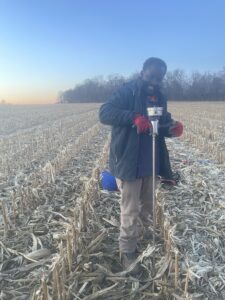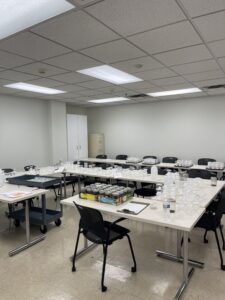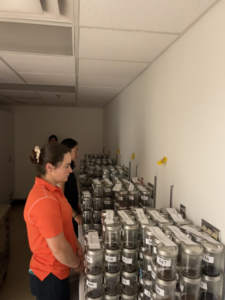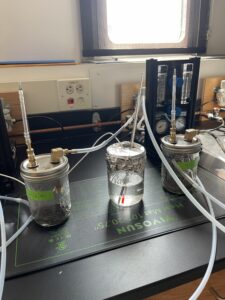Progress report for GNC23-381
Project Information
Unearthing the Scent of Soil Health: A Validation of Smell through Odorant VOCs for Farmer Assessment
Farmers routinely perceive soil smell in daily field activities. Soils emit a diversity of odorant volatile organic compounds (VOCs), many hypothesized to be relevant to soil health processes. For example, an “earthy” aroma is associated with soil microbial activity, whereas “metallic” smells are associated with compaction. Farmers looking to implement soil health-promoting practices often face barriers to soil health testing. An alternative or complementary approach is farmer-based empirical assessment. While quantification of complex sensory profiles is challenging, sensory assessment panels are routinely used to assess air quality in regulatory industries, validation of smell as a soil health indicator (SHI) would enable a breakthrough in farmer assessment of soil health.
Profiling the VOC emissions responsible for soil smell presents an opportunity to validate smell as an SHI. To achieve this, we ask two questions: First, is soil VOC emission related to soil smell? Second, can soil smell traits be validated as a SHI for farmer-driven soil health assessments? Our objectives are to i) establish a semi- quantitative smell profiles from farmer-based smell assessment panels, i) establish VOC emission profiles for smell profiles, then iii) relate smell profiles and constituent VOC emissions to established USDA NRCS SHIs to validate soil smell as a SHI.
Through collaboration across soil science, sensory science, and chemical ecology, we will profile VOC emissions and conduct farmer-based smell assessment to characterize smell profiles of soils from a range of management practices (e.g. extended crop rotation, livestock integration) for each of two major soil orders of the North Central US. Analysis of the relationships between smell profiles, VOC emission profiles, and SHIs will be conducted to validate smell as an SHI, resulting in a framework to interpret smell as a SHI. This project aims to increase farmer use of soil health testing through producing 1) the knowledge to interpret soil smell as an SHI and 2) an accessible evidence-based on farm tool to support traditional soil health testing during management decisions. In order to disseminate our findings, results will be published in a peer reviewed publication, a popular press article, a webinar, and through several field days followed by a survey to assess project impact on farmer knowledge, skills, attitudes, and awareness towards SHI use and implementation.
Learning outcomes: This research project will generate knowledge on how the smell of soil produced by VOC emissions can be empirically interpreted as an indicator of soil health. By incorporating farmers into the planning and experimental phase of this project, then directly engaging a broader community of farmers through outreach, we anticipate knowledge gained to undergo both formal (popular science article, webinar, field days) and informal (word of mouth) transfer into the regional farmer community.
Action outcomes: The action outcome of this research project is to increase farmer use of soil health testing in the north central region. Since soil smell is rapid and inexpensive, we expect that the results of this project will increase farmer use of soil testing, which will improve long term soil health outcomes as farmers will be better equipped to make optimal management decisions. Once validated, smell can be interpreted as a low-cost and rapid supplement to quantitative as lab-based metrics. We expect sustainably minded farmers to implement soil smell as a soil health assessment tool to supplement traditional soil health testing. For example, rather than spending additional funds on tests for biological soil health, which are highly variable, not well calibrated to agroecological outcomes, and expensive, farmers can infer information from soil smell in conjunction with traditional fertility tests to make management decisions.
Cooperators
- (Researcher)
- (Researcher)
Research
Soil Sampling, Selection, and Characterization
Sampling. Soils were sampled post-harvest (December 2023) from 18 fields across commercial farms in Illinois and Indiana. To furnish a range of soil health (SH), we sampled 3 cropping system types intended to correspond to relatively low (L), moderate (M), and high (H) soil health (SH) based on NRCS soil health principles SHPs: corn-soybean with regular tillage (yearly chisel tillage) and no cover crops (L), no-till corn-soy with cover crops (M), and permanent grazed pasture (H), which was then validated using NRCS recommended soil health indicators. Sampling was conducted to represent the common soils of the north central region. To reduce variability from crop rotation in the row cropping systems, soils were sampled coming out of the maize phase. Soils were sampled from 0-15 cm depth and composited from 8 points within a 1 m radius. Soils were collected below 0˚C and stored at 4 ˚C until being air-dried, ground, and sieved for (<2mm) analysis within 7 days of collection, with exception of soils subsampled for phospholipid fatty acid analysis (PLFA) which were stored at -20 ˚C for 3 days prior to analysis.
Sample selection for odor panel. To facilitate the multiple samples forced ranking test, 9 soils were selected to represent L, M, and H SH, with 3 field replicates at each level. Selected soils demonstrated distinct values based on the analytical SH score and individual SHIs to maximize differences in SH between levels. Beyond these discrete designations, four additional soils were included in descriptive analysis, alongside double acid washed quartz (0.53-2mm) as an odorless negative control.
Characterization. Soils were characterized for texture via the hydrometer method, cation and anion exchange capacity with the Nunes and Mulvaney 2021 method, pH was determined with a 1:1 soil to water ratio, and taxonomic classification data was determined using SSURGO.
Soil Health Analyses. Several NRCS recommended SHIs were selected: mineralizable C, microbial biomass (chloroform fumigation and PLFA methods), permanganate oxidizable C (POXC), particulate organic matter C (POMC), and soil organic C (SOC). All SHI analyses were performed in analytical triplicate.
Odor Panel
Recruitment and Screening. Farmers were recruited through local farmer networks in central Illinois and Indiana. 10 farmers were selected under the criteria that they had experience with crop production in the east central US Corn Belt. Participation was approved as minimal risk by the University of Illinois Urbana-Champaign Internal Review Board #23-0254. Farmers were compensated for participation. The average age of the panel was 53.3+/-19.6. To ensure adequate olfactory function farmers completed the University of Pennsylvania Smell Identification Test (UPSIT) 1 week prior to participation in the first sensory lab visit and were asked to self-report any symptoms of cold, allergies, or other conditions which may impair olfactory function.
Soil and Reference Preparation. Soil incubations were standardized by using 25 +/- 0.25g soils rewet to 50% water holding capacity (WHC) and incubated at room temperature (25.6˚C) for 24h. We opted to use sieved and dried soils since standardization was critical for panel performance. Reference odors were prepared 24h prior to the sensory panel. Aroma standards from Le Nez were prepared by placing one drop of liquid (0.05mL) and stored in a 5.5oz sample cup with lid. Le Nez odor references were purchased from both Le Nez (Whisky, Coffee, and Wine Fault Kits) and Aroxa, consistent with the recommendation of the World Coffee Research sensory lexicon.
Prior to the discussion phase of the smell panel, as many references for odor attributes were gathered as possible to assist panelists with clarifying and finding appropriate references for specific odors. During the training and testing phase of the panel, only the references selected by the panel as examples of odors were prepared. Prior work on soil odor of Mollisols in Iowa, odor wheels from natural products such as compost, water, and paper decomposition, and a pre-participation survey administered to farmers informed possible reference odors. A set of references were provided for every 2 panelists.
Soil Smelling. General good practice was employed when smelling samples or references. After opening the soil incubation, a deep inhale ~3 seconds, followed by a 10 second pause to partially restore olfactory receptors. Between samples, farmers were instructed to cleanse by breathing through a clean terry cloth, provided as a new, scentless terry towel per each farmer during each session. Bottled water was freely provided. To standardize the smelling, farmers concurred ~2 seconds should pass between removing the lid from the jar and sniffing. All odor analysis was conducted using red lighting in sensory booths to avoid unintended effects of soil color.
Multiple Samples Forced Ranking (MSFR). The multiple samples forced ranking (MSFR) test was administered as an attribute difference test. The MSFR was conducted prior to descriptive analysis as ranking requires minimal training, could serve as the frame of reference exposure, and to avoid bias towards specific odor characteristics. Three samples, one from each pre-defined, discrete SH level, were simultaneously presented to a farmer, who was instructed to rearrange them in rank order of low to high perceived soil health. This design resulted in 27 possible sample presentations to represent all possible combinations of L-M-H (Meilngaard et al., 2007). Sets were blocked into three blocks: each panelist was randomly assigned two blocks so that each panelist evaluated 18/27 of the unique sets and was exposed to each individual soil sample 6 times. Samples were presented simultaneously, and ties were not permitted. Farmers were instructed “to rank the samples according to perceived soil health” and provided with the NRCS definition of SH: “The continued capacity of the soil to function as a vital living ecosystem that sustains plants, animals and humans”, though were encouraged to draw on their own experiential understanding of SH. Panelists were provided with a 15-minute break midway through.
Descriptive Analysis. The descriptive analysis was adapted based on the principles of quantitative descriptive analysis (Stone and Sidel 1985, 2004, Lawless and Haymenn 2010) to discriminate and describe qualitative and quantitative aspects (Meeliengaard et al., 2007, p. 173) of soil odor. Lexicon development was conducted using a hybrid of the consensus and ballot methods (Lawless and Haymenn 2010, p. 240): the vocabulary used was achieved both through reaching agreement by the panel (Lawless and H 2010, p. 233, p. 240) and the panel provided a list of potential descriptors and references (Lawless and Haymenn 2010, p. 240). Conducting the soil health ranking prior to the terminology development served as a frame of reference (Meilgaard et al., 2007, pg. 152) to define the sensory space. Terminology development began with a list of all possible odor descriptors (Meillengard et al., 2007), drawing on background knowledge of soil smell via an online pre-participation survey, on the frame of reference MSFR task, and available soils. It was important that the terminology used to describe the soil odors be generated by the panelists themselves (Descriptive Sensory analysis in practice, page 44). Next, the long list of potential descriptors was consolidated into a working list of comprehensive (describe entire category, e.g., “sweet” would be more appropriate than “apple” if all of the sweet smells do not smell like apple) and discrete (minimal overlap between descriptors) descriptors (Meillengard et al., 2007, pg. 153), so that there are no redundant terms (Lawless and Haymenn 2010). During this process, panelists were encouraged to clarify concepts using reference odors, and to select terms which were unambiguous and easy to interpret (Lawless and Haymenn 2010). From the list of all possible odor descriptors, a discrete list of descriptors which minimized overlap was established (Meillengard et al., 2007). The final stage of terminology development involved selecting external references (and products) to be good examples of the selected terms (Meillengard et al., 2007). When possible, the panel was instructed to designate an appropriate reference material (Sidel and Stone 1985), though not always necessary if the reference material for the term did not exist and the term could be clearly defined (Lawless and H 2010, p. 241). Panelists were encouraged to use references to signify the boundaries of the descriptors (Meillengard et al., 2007) and minimize variability generated from inconsistent perception of terms (Stone and Sidel 1985, 2004). The goal was agreement on term meaning, concepts and the precise terminology (Meillengard et al., 2007). Once satisfied with the terms, the panel was instructed to proceed to evaluation (Sidel and Stone 1985), where several soils were evaluated through consensus as a group. Within one week, an individual training session was conducted (~45 minutes) to familiarize the panelist with methods of the descriptive analysis test procedure, improve the individual’s ability to recognize and identify sensory attributes in the test sample (ATSM 2023), and conduct a sensory calibration with the 5-point scale (Lawless and Haymenn 2010). The individual training session included a matching and discrimination test and was conducted to both reinforce and additionally train the panelists to reference odors for the selected attributes and to familiarize panelists with the process with soil samples (Meilgaard et al., 2007). The qualitative descriptive analysis was conducted during a follow-up testing session within 1 week of the training session. Each panelist evaluated the intensity of the 5 odor attributes on a dimension-by-dimension basis (Sidel and Stone 1985). The 13 soils and control were sequentially presented in a balanced random order (Meilgaard, et al, vol 1, 1987). Each set was presented 3 times in randomized order with different blind coding to improve accuracy (Meilgaard, et al, vol 1, 1987). Each attribute was assessed using a linear scaling technique known as scoring on a 5-point scale, which also included a “none” value (Meilgaard, et al, vol 1, 1987). Panelists were instructed to evaluate each odor attribute separately, however it is recognized that evaluating all odor attributes at the same time would generate some interdependence between attributes. Panelists were made aware of this potential bias and instructed to recognize each attribute individually (Meilgaard, et al, vol 1, 1987).
Complementary Volatile Organic Compound (VOC) Analysis
Currently, we are conducting both targeted and untargeted VOCs using incubation conditions identical to those used for the odor panel. We have experimented with various extraction techniques such as push-pull extractions, and decided on solid phase micro extraction (SPME) (65 µm polydimethdimethylsiloxane-divinylbenzezne (PDMS/DVB) fused silica and stainless-steel fiber)) to best mimic incubation conditions and support simultaneous targeted and untargeted analysis.
The targeted analysis enables quantitation of the known fresh damp and musty stale earthy VOCs geosmin, and 2-Methylisoborneol (2-MIB), respectively, following the GC-MS optimization developed by Conrady et al., 2021. Untargeted analysis to identify unknown compounds related to odor make use of the NIST software using an eicosane reference, and with a column programed to 40 °C/2 min, 5 °C/min to 200 °C, for a total of 40 min, and injector and transfer line temperatures were 200 °C.
For untargeted results, we will identify known odorant compounds through the OlfactionBase software. With both targeted and untargeted results, we will correlate odorant compounds and the reduced dimensionality VOC profiles (derived from non metric multidimensional scaling and associated procedures) to the odor attributes and components of odor profiles derived from the sensory data. This will enable us to identify compounds and clusters of co-occurring compounds corresponding to the odor attributes identified in the soils, and pertinent to soil health status.





Currently, we are completing data analysis of the soil odor data, and in the data collection stage for the VOCs. Below are preliminary results of the odor panel portion of the project, including the lexicon development. Analysis of the results from the multiple samples forced ranking test to evaluate the ability of farmers to assess soil health via smell, and the descriptive analysis test, to derive odor profiles for these soils is currently underway.
During lexicon development, the panel agreed on five distinct odor attributes: fresh damp earthy (FDE), musty stale earthy (MSE), earthy sweet (ES), chemical or mineral (CM), and putrid (P). Farmers distinguished between earthy odors through odor character and hedonic affect: FDE was associated with a pleasant earthy smell, with damp, moist, and fresh character, whereas the MSE attribute was described as unpleasant, like wet brick, mold, or stale water. The sweet odor attribute in ES was not a “fruity sweet”, but exhibited earthy character captured by oak, chocolate, fresh cut grass, walnut, hay, and tobacco leaf reference odors.
Table 1. Odor attributes with descriptions and references determined by panel consensus. Source for the reference is included in parentheses.
|
Odor Attribute |
Description |
Reference(s) |
|
Fresh Damp Earthy |
A pleasant earthy smell with damp, moist, and fresh character, reminiscent of organic matter such as compost, living worms, root vegetables, mushrooms, or dairy products. |
ethyl fenchol (aroxa) potato (le nez) mushroom (le nez) geosmin (aroxa) |
|
Musty Stale Earthy |
An unpleasant earthy smell, like wet brick, mold, or stale water. |
2-MIB (aroxa) TBA (aroxa) TCA (aroxa) |
|
Earthy Sweet |
A distinctive sweet smell with an earthy rather than a fruity sweet character. Includes herbaceous floral notes such as hay and tobacco leaf. |
oak (le nez) chocolate (le nez) fresh cut grass (le nez) walnut (le nez) hay (le nez) tobacco leaf (le nez) |
|
Chemical / Mineral |
A chemical, mineral, or natural gas smell. |
styrene (aroxa) medicinal (aroxa) petrol (aroxa) |
|
Putrid |
A rotten smell, like rotten or decaying earthworm. |
rotten egg (le nez) rotten vegetable (le nez) methanethiol (aroxa) isovaleric acid (aroxa) |
Educational & Outreach Activities
Participation summary:
We are currently working on two articles for peer review publication from this project, and a popular press article aimed at a broader non-academic audience. We are also planning an in-person field day on-farm in central Illinois to present the results of the study and engage farmers with our findings in a hands-on learning experience. During this field day, we plan to disseminate fact sheets and brochures which highlight the findings of the study.
Project Outcomes
We have not yet reached the stage of outcome evaluation. However, based on initial informal farmer feedback, we expect this study to have a positive impact on soil health measurement in the north central region. While farmers, especially those who participated in the smell panel, already value soil health, we expect this study will empower these farmers to incorporate informal smell assessment of their soils into their current soil testing framework, and to share this knowledge through the farmer to farmer networks. By participating in the language development process, these farmers are now equipped with the skills to identify and describe soil odors which were previously difficult to articulate. We expect that this study will encourage soil health assessments to encourage inclusion of sensory assessment and use of complementary VOC analysis.
During this project, I have valued the opportunity to work closely with farmers to discuss soil health and sustainable agriculture. The farmers participating in the odor panel bring unique and valuable perspectives to the project. As we move forwards into the final stages of this study, we will be able to quantify the knowledge, attitudes, skills, and awareness gained.
This small scale project was a novel investigation into soil odor for soil health assessment, and has established a foundation for studying soil odor. The preliminary results already indicate the value for several follow up studies. There are several open questions, including investigating “soil terroir”: certain odors could be specific to soil locations and/or characteristics. Additionally, it is unclear if the ability of farmers to estimate soil health through smell is specific to farmer populations acquired through experience, or if broader populations have this ability. Further studies should also investigate this phenomena in other regions beyond the north central region. There is also a need to conduct further research with field fresh soils to determine the extent to which we can extrapolate results from this study.
On the VOC analysis side, there is also ample opportunity for future research. This includes methods development and optimization to determine the VOC extraction conditions and techniques most sensitive to soil health status. Given the complexity of soil VOCs, there is opportunity to utilize higher resolution mass spectrometers to improve our untargeted metabolomic analysis. Additionally, future research should consider in situ conditions such as moisture and temperature, and importance of soil structure in mediating VOC generation and release.